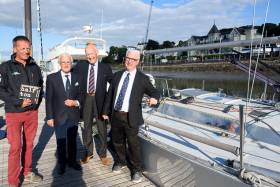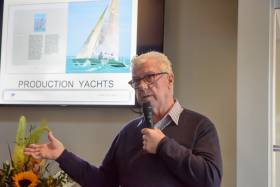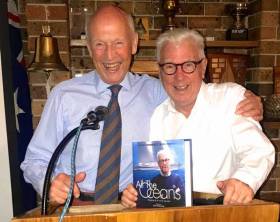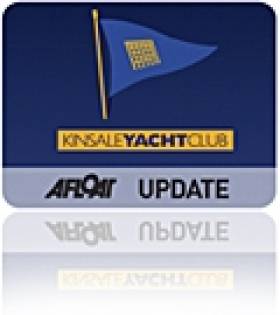Displaying items by tag: Ron Holland
This week’s slot in the Royal Irish Yacht Club’s ‘Home Together’ series of online talks sees yacht designer Ron Holland headline a new mini-series featuring some of the best known names in international yacht design.
Julian Everitt, Mark Mills and John Corby are some of the other legendary figures who will give their own virtual talks over the coming weeks, following Holland’s introductory talk tomorrow evening (Wednesday 13 May)
And what’s more, Holland will be joined on this panel by Ireland’s own veteran sailing superstar Harold Cudmore.
For over 50 years, Ron Holland’s innovative designs have repeatedly shaken up the world of sailing.
Renowned as one of the most successful and sought-after designers in the highly competitive world of international ocean racing, he later brought his influence to — and continues his success in — the superyacht industry.
Holland’s online talk is set for 6.30pm on Wednesday 13 May. Contact [email protected] to register to attend.
Yacht Designer Ron Holland Wins Lifetime Achievement Award
One time Irish based yacht designer Ron Holland has won a Lifetime Achievement Award at the Superyacht Design Symposium 2019, and Boat International Design and Innovation Awards
The competition included a total of 61 nominated yachts with 19 receiving recognition. In addition to the boat categories, the ceremony honoured two individuals, Yihharn Liu for Young Designer of the Year, and Ron Holland for the Lifetime Achievement Award.
Last June, the designer was reunited with one of his first boats 'Silver Shamrock' at Royal Cork Yacht Club as Afloat.ie reported here.
Superyacht ‘Christopher’ Returns To Dun Laoghaire
#Superyachts - Afloat.ie has learned that superyacht Christopher is moored in Dun Laoghaire Marina this morning (Monday 13 August) after passage from Belfast.
The 46m Ron Holland-designed cruising ketch previously sailed into Dublin Bay in June 2014, when it was considered Dun Laoghaire’s largest ever visiting yacht.
Since then the marina has hosted various other super-sized vessels — including the 35.8m Arcadia, a yacht sturdy enough to transit the Northwest Passage — which prompted Afloat.ie to ask whether a dedicated superyacht berth could be a realistic proposal for Dun Laoghaire.
A unique gathering at Royal Cork Yacht Club last night brought yacht designer Ron Holland's tour of south coast Irish yacht clubs to a close.
Midsummer night’s brought together old Crosshaven shipmates from way back but the star of the show was the first Irish-produced World Champion of them all - Silver Shamrock of 1976 Half Ton World Championship fame, now owned by the current Irish “Sailor of the Year” Conor Fogerty of Howth who was also in attendance in Crosshaven.
Master of Ceremonies John McWilliam saluted the Kiwi designer's role in Irish sailing success down the years and a packed RCYC clubhouse – that included an audience of sailors from the very young to the very old – heard the Kiwi designer speak about his life in boats.
Spotted among the crowd for Ron's talk were Cork Harbour locals Naomi James, the first woman to have sailed single-handed around the world via Cape Horn, Commodore's Cup-winning captain Anthony O'Leary, Neil Kenefick, Eddie English and former yacht broker Donal McClement.
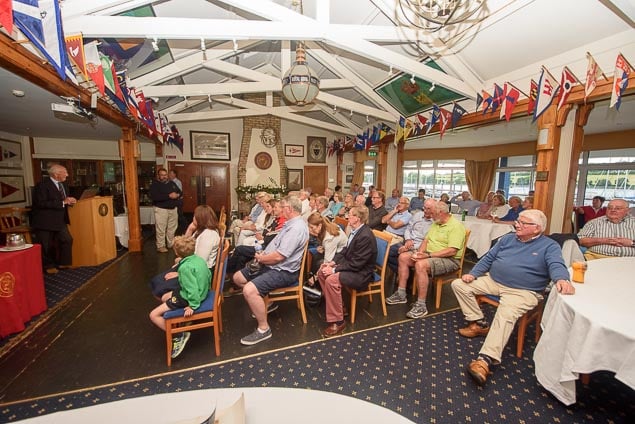 The packed clubhouse at RCYC for John McWilliam's introduction Photo: Bob Bateman
The packed clubhouse at RCYC for John McWilliam's introduction Photo: Bob Bateman
Listen to a podcast with Afloat.ie's Tom MacSweeney here and read Afloat.ie's WM Nixon on the Ron Holland story here.
Photos by Bob Bateman of last night's gathering below
 Ron Holland signs a photograph for Dick Gibson (right) Photo: Bob Bateman
Ron Holland signs a photograph for Dick Gibson (right) Photo: Bob Bateman
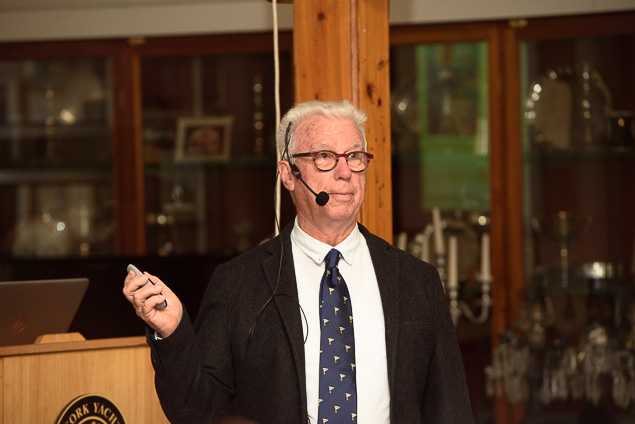 Ron Holland speaking about his life in boats at Royal Cork Photo: Bob Bateman
Ron Holland speaking about his life in boats at Royal Cork Photo: Bob Bateman
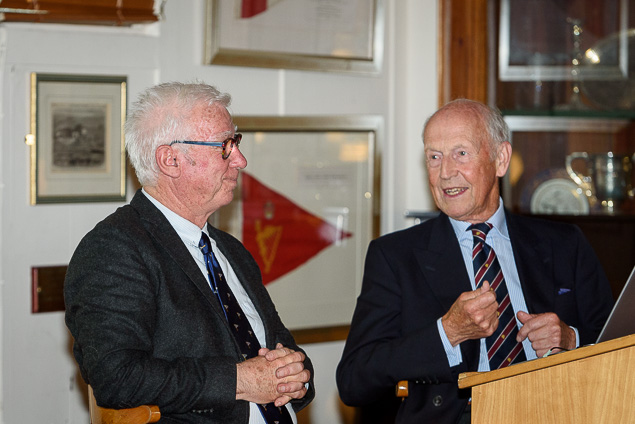 Ron Holland with Master of Ceremonies John McWilliam (right) Photo: Bob Bateman
Ron Holland with Master of Ceremonies John McWilliam (right) Photo: Bob Bateman
 Hugh Gibson, Anthony O'Leary and Eddie English Photo: Bob Bateman
Hugh Gibson, Anthony O'Leary and Eddie English Photo: Bob Bateman
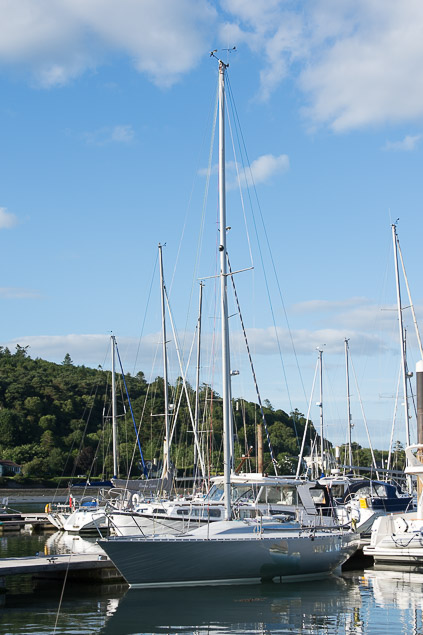 World beater – Ron Holland's 1976 Silver Shamrock alongside in Crosshaven
World beater – Ron Holland's 1976 Silver Shamrock alongside in Crosshaven
 Georgina Campbell and Afloat's Willliam Nixon Photo: Bob Bateman
Georgina Campbell and Afloat's Willliam Nixon Photo: Bob Bateman
 Neil Kenefick (left), Ron Holland (centre) and Stuart Brownlow Photo: Bob Bateman
Neil Kenefick (left), Ron Holland (centre) and Stuart Brownlow Photo: Bob Bateman
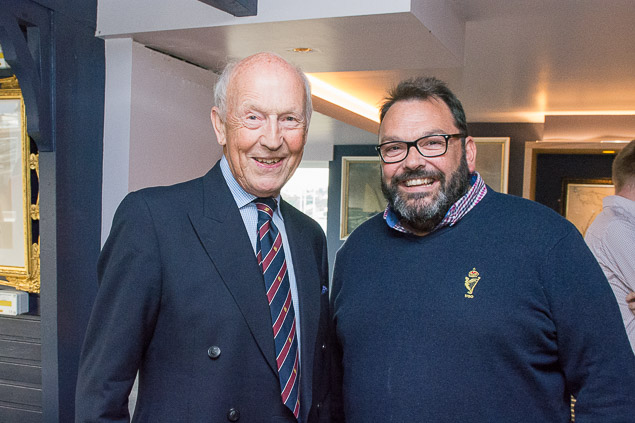 John McWillian (left) with RCYC Vice Admiral Colin Morehead Photo: Bob Bateman
John McWillian (left) with RCYC Vice Admiral Colin Morehead Photo: Bob Bateman
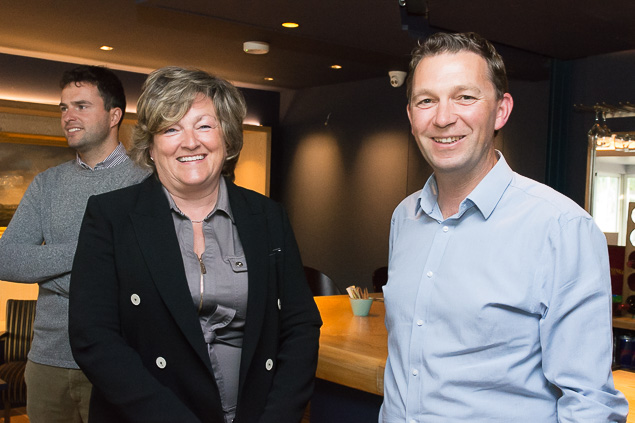 April English with RCYC CEO Gavin Deane Photo: Bob Bateman
April English with RCYC CEO Gavin Deane Photo: Bob Bateman
Yacht Designer Ron Holland on Beating the English
Ron Holland has been back in Ireland this week, at two yacht clubs he knows well - Kinsale Yacht Club and the Royal Cork Yacht Club at Crosshaven, across the Owenabue River from Currabinny where he designed race-winning yachts.
“If you want to be famous in Ireland, beat the English,” he told me when we talked in Kinsale.
“We took these boats, Golden Apple and Irish Mist, to England and beat the hell out of the English. So I became quite famous in Ireland in the 70s and that was fun.”
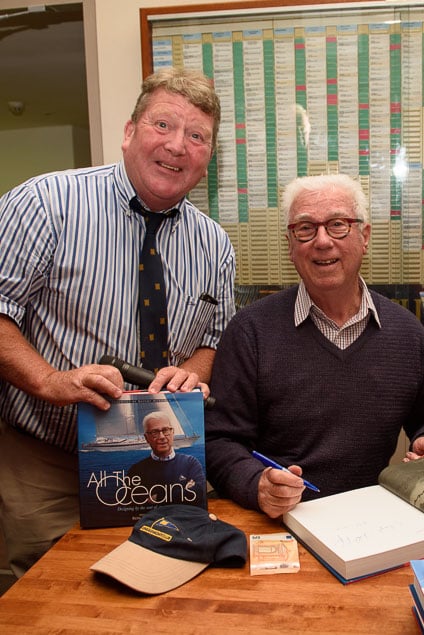 Ron Holland signs a copy of his new book for KYC Commodore Dave Sullivan Photo: Bob Bateman
Ron Holland signs a copy of his new book for KYC Commodore Dave Sullivan Photo: Bob Bateman
This is one of the stories he recounts in his book, ‘All the Oceans,’ from Cardinal Publishing, which he has been promoting on his book tour in Cork. Over 400 pages and with 200 photographs it recounts his life journey from his first sailing dinghy, a 7-footer, yes just seven feet, in New Zealand, to the designing of superyachts.
 The gathering for Ron Holland at Kinsale Yacht Club Photo: Bob Bateman
The gathering for Ron Holland at Kinsale Yacht Club Photo: Bob Bateman
He is photographed with the 7-footer at the end of the book – “Quite a nice way to finish the story of a sailing lifetime.”
Ron will be back in Ireland in September, visiting clubs in Dublin.
For this week’s Podcast, I started by asking him what was the attraction of sailing for him. In the interview, he has a strong message for young people - not to fear educational failure, but to be determined and to grab opportunities, which has been his personal experience, leading not only to Irish but international fame…
Listen to my Podcast interview with Ron Holland below.
Like many New Zealanders, the young Ron Holland was mad keen about boats and sailing. And like several eventually distinguished fellow-countrymen, he has found his life path through a successful career in the international yacht design industry, right up to the dizzy heights of visualising some of the most remarkable superyachts in the world writes W M Nixon.
But while the other young would-be Kiwi boat-creators went forth to become associated with already-established international centres of the global marine industry, the twists and turns of life in the early 1970s saw the young Ron Holland being encouraged to settle in Crosshaven.
There, after the success of the Royal Cork Yacht Club’s Quarter Millennial Celebrations in 1969-70, the growing confidence and developing enthusiasm of local sailors was to see the rapid development of the local marine industry. It came about through a dynamic interaction between newly-arrived talents such as sailmaker Johnny McWilliam and designer Ron Holland, and the brilliant boat-building abilities of renowned Crosshaven-based families such as the Bushes and Leonards.
 Ron Holland, aged 26, helming his own-designed-and-built 24ft Eyghthene to the Quarter Ton World Championship in 1973
Ron Holland, aged 26, helming his own-designed-and-built 24ft Eyghthene to the Quarter Ton World Championship in 1973
Development and expansion of this quality could not have taken place without the support of the growing band of great Cork sailing families, veritable dynasties such as the Coveneys, the Loves, the O’Learys, the Cudmores, the Doyles, the Keneficks and the Mansfields – all these renowned names at some stage found themselves racing a new Ron Holland-designed boat. And some – such as Hugh Coveney, Archie O’Leary and Harold Cudmore Jnr - pioneered the way into the winning frame in international competition.
Thus although Ron Holland-designed boats had been a force to be reckoned with ever since he came to world prominence by topping the Quarter Ton Worlds in England in 1973 with his own-skippered-designed-and-built 24ft Eyghthene, getting involved with the vibrant Crosshaven of the 1970s saw his career move up several gears.
 A production Eyghthene 24 built in Poland
A production Eyghthene 24 built in Poland
He’d built Eyghthene while working in Florida, but the focus for the Ton Cup championships was to be found in Europe, with his American friend Doug Peterson’s One Tonner Ganbare showing the way forward in 1973 in the One Ton Worlds Italy while Ron was doing his winning on the south coast of England.
The One Ton level was what interested Hugh Coveney in Cork, and between the jigs and the reels, by the late Autumn of 1973 Ron Holland found himself in Crosshaven, involved with a team which included the hyper-talented though still very young Killian Bushe, building the 36ft One Tonner Golden Apple. She may, in the end, have taken the runner-up slot in the One Ton Worlds at Torquay in Devon in England in 1974, but with her many innovative features including a Bergstrom-Ridder rig, she attracted every bit as much attention as the winning Doug Peterson-designed Gumboots.
 A boat of real charisma: Hugh Coveney’s One Tonner Golden Apple of 1974
A boat of real charisma: Hugh Coveney’s One Tonner Golden Apple of 1974
The Holland reputation was further enhanced when one of his early production designs, the 33ft Nicholson Three Quarter Tonner Golden Delicious, was overall winner of the 1975 Fastnet Race.
Yet it wasn’t until 1976 that one of the growing and developing Cork lineup of locally-built new Ron Holland designs was to win a major world title. But as this was the Half-Ton Worlds at Trieste in Italy in 1976, when rising superstar Harold Cudmore Jnr did the business with Silver Shamrock, the Holland-Crosshaven show was really on the road, and Silver Shamrock’s crew memorably celebrated their victory by sailing up the Grand Canal in Venice with spinnaker set.
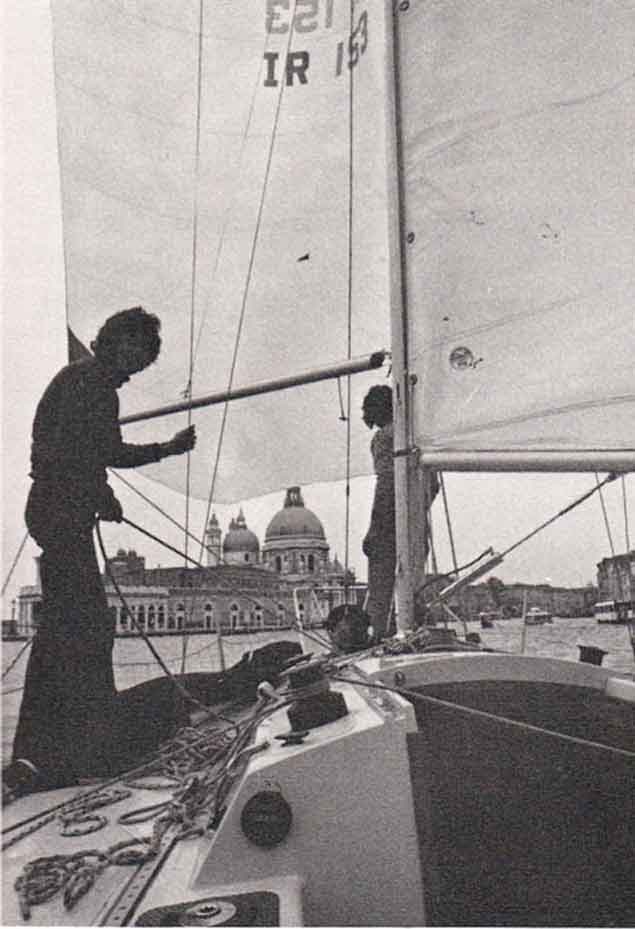 The only way to celebrate being Half Ton World Champions at Trieste in 1976 - Silver Shamrock sails up the Grand Canal in Venice with spinnaker set
The only way to celebrate being Half Ton World Champions at Trieste in 1976 - Silver Shamrock sails up the Grand Canal in Venice with spinnaker set
The Holland-designed production-built Shamrocks – in both their racing versions as the Golden and Silver Shamrocks, and in the popular Club version with improved accommodation – were widespread in Ireland in Crosshaven. Kinsale, Dun Laoghaire, Howth and other centres.
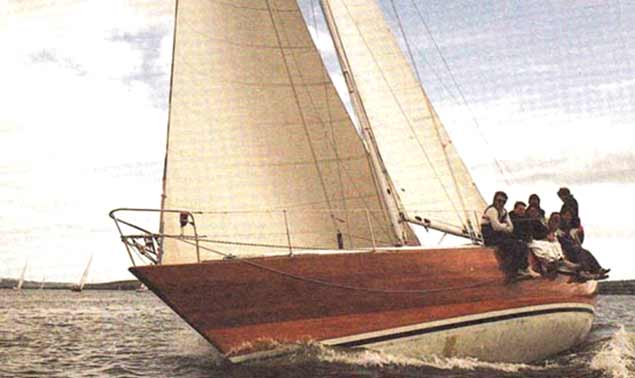 Archie O’Leary’s Two Tonner Irish Mist II was another consistently successful performer. Photo courtesy RCYC
Archie O’Leary’s Two Tonner Irish Mist II was another consistently successful performer. Photo courtesy RCYC
Notable in this golden era for Crosshaven campaigners working with Ron Holland and Johnny McWlliam and the rising talents emerging with them were the O’Leary family with their fabulous 40ft Two Tonner Irish Mist II, and the Clayton Love/Hugh Coveney/Ray Fielding triumvirate in the utterly gorgeous 44ft Big Apple, winner of the Concours d’Elegance (and many races) in the 1977 Admiral’s Cup.
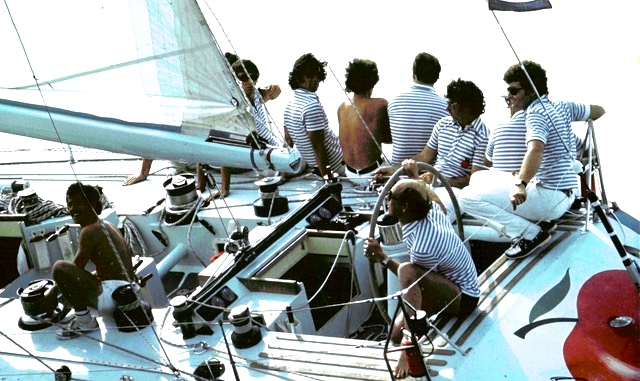 Men at work…aboard Big Apple, on her way to a race win in the 1977 Admirals Cup, with Johnny McWilliam on the helm and Harry Cudmore keeping a close eye on things, crouched on the weather quarter. Photo courtesy John McWilliam
Men at work…aboard Big Apple, on her way to a race win in the 1977 Admirals Cup, with Johnny McWilliam on the helm and Harry Cudmore keeping a close eye on things, crouched on the weather quarter. Photo courtesy John McWilliam
This enthusiasm reached another peak in 1979 when the new Ron Holland-designed 42ft Regardless – for Ken Rohan of the Royal Irish YC on Dublin Bay – joined the Holland-design-dominated flotilla at Cork for the 1979 Admirals Cup selection trials. With a broader transom which moved away from the more pin-tailed earlier Holland designs, Regardless was a brilliant all-rounder - in fact, many reckon she was probably the best all-round offshore racer Ron ever designed, a lovely boat to sail, and a guaranteed winner.
So although a broken rudder meant she had to pull out of the 1979 Fastnet Race (which Ireland had gone into leading the Admirals Cup series), Regardless came back for the next Fastnet in 1981, and won Class I going away.
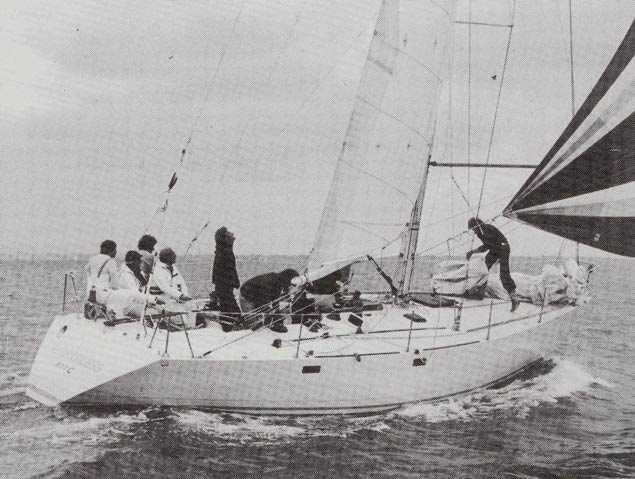 Ken Rohan’s Regardless of 1979, seen here racing in Dublin Bay with Sean Flood on the helm and Harry Byrne on mainsheet, is widely regarded as the best all-round racer ever designed by Ron Holland. Photo: W M Nixon
Ken Rohan’s Regardless of 1979, seen here racing in Dublin Bay with Sean Flood on the helm and Harry Byrne on mainsheet, is widely regarded as the best all-round racer ever designed by Ron Holland. Photo: W M Nixon
By this time, not only had Ron’s hyper-busy design office expanded to take on many talents, such as Tony Castro who in time went on to establish their own firms, but the level of work required ever-larger premises. So the company moved from its base in the Strand Farmhouse in Currabinny across the river from Crosshaven, to a handsome Georgian house right next to the yacht club in Kinsale.
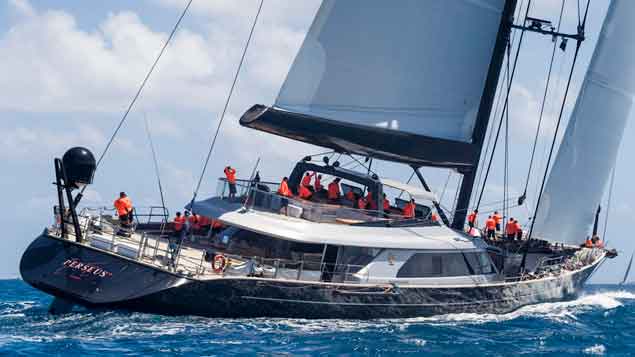 A highlight of Ron Holland Superyacht success – the 212ft Holland-designed sloop Perseus being skippered by Nin O’Leary of Crosshaven to runaway overall victory in the Lora Piana Caribbean Superyacht Regatta, March 2017
A highlight of Ron Holland Superyacht success – the 212ft Holland-designed sloop Perseus being skippered by Nin O’Leary of Crosshaven to runaway overall victory in the Lora Piana Caribbean Superyacht Regatta, March 2017
There, the firm was well-placed to handle the increasing stream of orders for much larger craft including Superyachts – both sail and power. The story becomes ever more complex, but fortunately for those who want to follow it in full detail, Ron Holland – who turned 70 last year – has been working on his memoirs for the book “All The Oceans – Designing by the seat of my pants” which has gradually been released on a worldwide basis, starting (as reported in Afloat.ie here) with New Zealand and Australia in February.
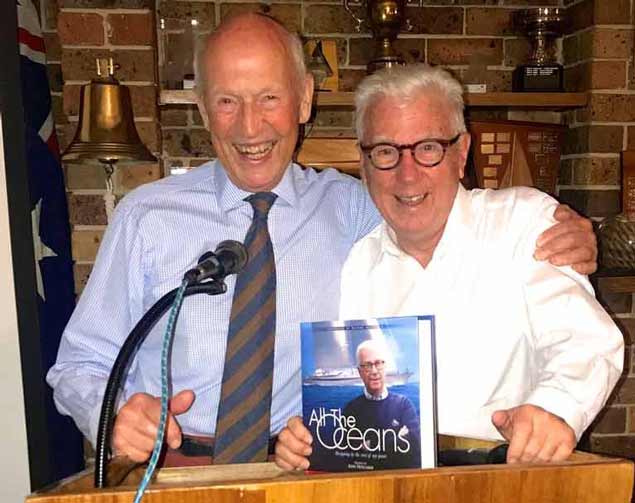 Johnny McWilliam and Ron Holland promoting the new book in Australia in February.
Johnny McWilliam and Ron Holland promoting the new book in Australia in February.
Other places such as the US and of course Canada have come into the loop, for Ron has been based in Vancouver since 2011, his design office in Kinsale having been taken over by Rob Doyle. In Vancouver, he keeps his own superyacht moored (Dun Laoghaire sailors please note) in the Coal Harbour, and he is so well settled into the thriving local sailing scene that when the International Classic 6 Metre Worlds was staged on his home waters last September, he had bought himself the vivid red Peter Norlin designed 6 Metre Nuvolari to race in the 45-strong fleet drawn from centres worldwide. And though he didn’t get himself into the frame, he and his crew enjoyed themselves enormously.
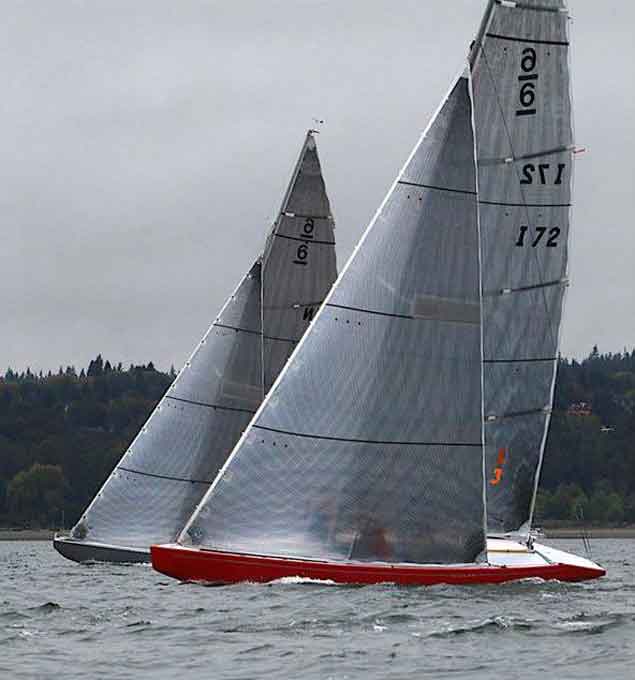 Ron Holland’s pet boat in Vancouver – the International 6 Metre Nuvolari, designed originally for Italian owners by Peter Norlin of Sweden. With a distinctive hull colour like that, you need to be very sure you’re not pushing it on the starting line…...
Ron Holland’s pet boat in Vancouver – the International 6 Metre Nuvolari, designed originally for Italian owners by Peter Norlin of Sweden. With a distinctive hull colour like that, you need to be very sure you’re not pushing it on the starting line…...
Next week, it’s Ireland’s turn for the launching of “All the Oceans”, which is being done with a sort of south coast book tour at Kinsale YC and Royal Cork YC.
It is truly a Midsummer Night’s Dream, for in addition to old Crosshaven shipmates from way back with the strong possibility of attendance by Harold Cudmore and Johnny McWilliam among others, the star of the show will be the first Irish-produced World Champion of them all - Silver Shamrock of 1976 Half Ton World Championship fame, and now owned by the current Irish “Sailor of the Year” Conor Fogerty of Howth.
If they can all manage to get together in Crosser, there won’t be a dry eye in the house.
 Still going strong. Ireland’s current “Sailor of the Year” Conor Fogerty of Howth’s vintage Ron Holland Half Tonner Silver Shamrock, World Champion in 1976 under Harold Cudmore’s command. Photo: Afloat.ie
Still going strong. Ireland’s current “Sailor of the Year” Conor Fogerty of Howth’s vintage Ron Holland Half Tonner Silver Shamrock, World Champion in 1976 under Harold Cudmore’s command. Photo: Afloat.ie
Ron Holland has Former Shipmate Johnny McWilliam to Help Him in Australian Launch of Memoirs
International yacht designer Ron Holland of New Zealand became renowned in 1973 when he won the Quarter Ton Worlds in England with the 24ft Eygthene, which he’d designed himself and then skippered to success writes W M Nixon. The first of hundreds of winning designs, the original Eyghthene is now lovingly-maintained and sailed in Poland, but Ron’s success has been such that today you’ll find Holland designs of all types and lengths up to super-mega-yacht size in every corner of the world where special boats gather.
Ron’s own career saw him based for many year in the Cork area, first in Crosshaven and then in Kinsale, while more recently he has operated his worldwide design business from Vancouver in Western Canada. It has been a long and complex story, involving many remarkable people and hundreds of fabulous boats - it would take a book to do it justice. So most appropriately, the man himself has been giving some time in recent years to put his multiple memoirs in order, and they recently appeared in book form: All The Oceans, intriguingly sub-titled “Designing by the Seat of My Pants”.
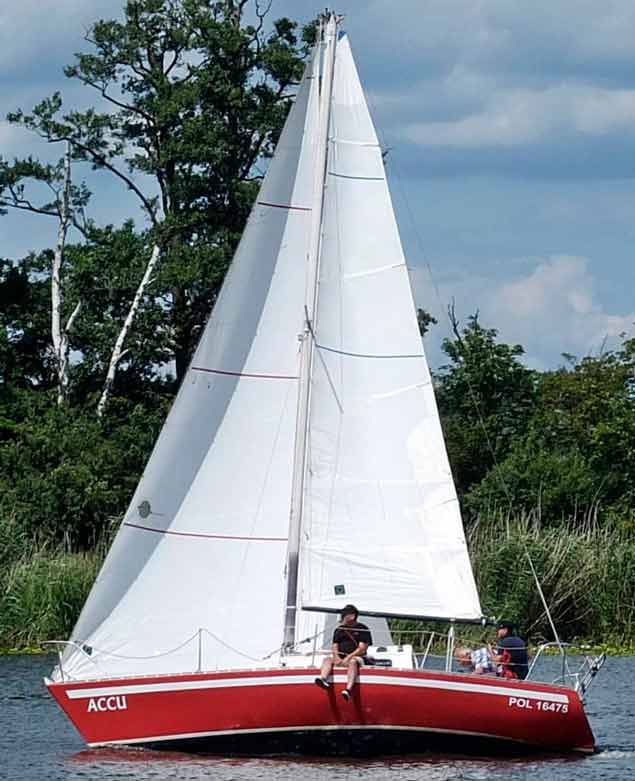 The successful little boat which started it all - the 24ft Eyghthene of 1973 is these days lovingly maintained and sailed in Poland
The successful little boat which started it all - the 24ft Eyghthene of 1973 is these days lovingly maintained and sailed in Poland
It’s intriguing because Ron and his notable team were pioneers in the use of Computer-Aided Design (CAD), yet despite that use of the latest technology, you can nearly always tell a Ron Holland design by some sixth sense. Like all great designers, he has his own individual trademark style which shines through the potentially anonymising effects of computers.
He also realises that even the most modern methods of communication cannot match the effectiveness of personal contact, so he is launching the book in a several-months-long tour for a series of events at global venues which reflect the extraordinary and peripatetic nature of his career. It began last month at the Royal Akarana YC in New Zealand, and yesterday it was the turn of the Royal Yacht Club of Victoria in Melbourne, Australia.
Being Australia, Ron was able to produce a secret weapon. In his early time in Crosshaven, much of his work was done in close collaboration with sailmaker Johnnny McWilliam. These days, however, Johnny’s great passion is gliding, in which he is skilled beyond international standards - before becoming a sailmaker, he was a jet fighter pilot. And as he likes to be able to go gliding on a year-round basis, Johnny spends the northern winters in Australia. So there he was, ready and willing to join Ron Holland in launching All the Oceans in the RYCV yesterday. As for the Irish launch, the word is that it is currently pencilled in for June.
 The kind of design Ron Holland is now most closely associated with – the Perini Navi Seven
The kind of design Ron Holland is now most closely associated with – the Perini Navi Seven
Rob Doyle Launches New Design Company
#Trade - Kinsale-based yacht designer Rob Doyle has announced the 'takeover' of the staff and offices of Ron Holland Design.
According to Superyacht Times, the 42-year-old issued a statement on Wednesday (27 March) outlining the changeover to his new yacht design, naval architecture and engineering business Rob Doyle Design, which is expected to take the previous company's work in a new direction with new design and refit projects.
"To have had the opportunity to work with Ron Holland over the past 18 years has been both a rare privilege and an eye opener as to what is possible," said Doyle.
"The experience I have gained and the lessons I have learnt make me want to explore more paths and develop further exciting projects with my team and build on Ron’s yacht design legacy."
Ron Holland, meanwhile, is still very much in the game - concentrating on his new centre of activity in Vancouver, where his company opened an office two years ago.
The mentor commented: "I look forward to continuing to collaborate with Rob on the projects that will carry the Ron Holland label and I also wish him all the best for the future of his own design firm and its projects."
Doyle has worked on a number of memorable projects under the Ron Holland brand, including the world's largest sloop Mirabella V and Ethereal, considered the most technically advanced superyacht yet developed.
Superyacht Times has more on the story HERE.
Kinsale's Ron Holland Expands
New Zealand-born Ron Holland established a reputation for designing exceptionally fast and successful racing yachts during the 1970s, working from his rapidly-expanding studio at Cork in the south of Ireland. Loyal owners soon asked him to design large cruising yachts too – they wanted comfort and style, but they wanted Ron to inject his talent for achieving performance and sea-keeping ability.
By the mid 1980s Ron had designed the world's first 100ft performance superyacht and after that he did not look back. He and his team have created a wide range of sail and power yachts for some of the world's wealthiest, most experienced and discerning clients. They include the 247ft/75m sloop Mirabella, which features the world's tallest single-masted rig; and the award-winning 150ft/46m Transocean Explorer, Marco Polo, which broke new ground with her innovative and energy-efficient propulsion systems.
Ron Holland Design's new Vancouver office is stunningly situated overlooking Coal Harbour and beyond to the snow-capped mountains surrounding Howe Sound. Here, Ron and his team will collaborate with their colleagues in Kinsale, led by Head Designer Rob Doyle, to provide an active and accessible platform for doing business with European, North American and Asia-Pacific clients and their advisers.
Ron Holland Vancouver already has projects in construction, out to yard tender or in advanced stages of design whilst, in the UK, the 150ft/46m custom ketch Christopher has just been launched at Pendennis Shipyard. Immediately following sea trials, Christopher will sail to the Caribbean island of St Barths where Ron Holland will join her enthusiastic owners to compete in the annual St Barth's Bucket. Christopher will be in good company at this special, 25th anniversary, edition of the Bucket Regattas as there will be at least five Ron Holland-designed superyachts also competing. In addition to Christopher, these are Mirabella V, Ethereal, Helios and Charlatan.
Ron Holland Design, Freedom Marine and Platinum Marine look forward to welcoming visitors to the RHD Open House at 100-510 Nicola St., Coal Harbour, Vancouver from 4 – 7pm on March 3rd 2011.
For further information and images, please contact: [email protected]
Quarter Ton Class Returns to Sovereigns Cup
The Quarter ton fleet is sailing back to the Sovereigns Cup in 2011. The event runs in Kinsale from June 22-25th.
The Quarter ton fleet made its debut at the 2009 event where a total of seventeen boats competed for the 'Keane's Jewellers perpetual Quarter Ton trophy'. Boats travelled from all over Ireland for the event with seven boats making the journey from the UK.
The four-day regatta was sailed on windward leeward courses, with one coastal race along the beautiful West Cork coastline. The coastal race proved memorable as the fleet short tacked their way along the shore to gain tidal relief in twenty knots of breeze and blazing sunshine with the race culminating in a long planning run back towards the mouth of the harbour.
After eight races the Cowes based yachtsman Peter Morton on 'Anchor Challenge' won the event on count back from Rob Gray's beautifully presented 'Aquilla' which was testimony to the close racing experienced within the fleet. The Ron Holland prize for best production boat was awarded to Kinsales' Ian Travers on his Bolero 'Bandit'.
The inclusion of the class in the 2009 regatta developed a lot of interest both during and after the event. Since then the Irish Quarter ton fleet has developed with the addition of some new boats with others currently undergoing refit for next season. With the recent announcement by the Quarter ton class in the UK to yet again include this event on their calendar for next year, it is highly likely that even in these recessionary times, the class numbers will grow for this truly enjoyable event. (See www.quartertonclass.org )
If you are interested in bringing your quarter tonner to Sovereigns Cup 2011 please contact Ian Travers @ +35387 9481576 or [email protected] or see HERE for further details.





























